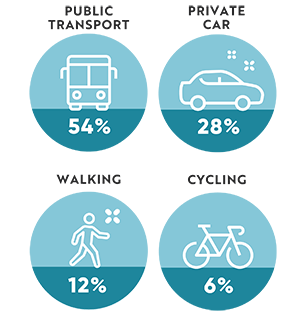Theme 6: Sustainable Movement and Transport

 Introduction
Introduction
Transport accounts for approximately 20% of CO2 emissions at national level. It is the greatest consumer of energy and the highest contributor to noise and air pollution. Dublin City Council acknowledges the importance of transitioning to low carbon mobility solutions to mitigate against the negative impacts of transport and climate change and will continue to address this through an integrated set of measures in the forthcoming Plan.
The policy approach within the City over the last two decades has been to integrate land use and transportation and to encourage a shift from private car use to walking, cycling and public transport. Policy has increasingly focused on the health and social benefits of active travel and the role that high quality public realm plays in encouraging walking and cycling. Proactive engagement with communities, schools, businesses and other stakeholders to collaboratively bring about behavioural change has been a more recent policy focus. Shared mobility has been embraced by Dubliners and visitors alike since the launch of JustEat dublinbikes in 2008. Since then, the City Council has facilitated and encouraged the operation and expansion of car share and stationless bike schemes.
While the policy emphasis in the new Development Plan will continue to focus on sustainable mobility, the global Covid 19 pandemic highlights the need to accelerate a shift to active travel, and in particular, the consequent upscaling in infrastructure provision for pedestrians and cyclists. It also emphasises the need for serious consideration of micro mobility, such as e-scooters, as part of an integrated set of mobility measures. The new Development Plan will look to the future of mobility in the City including the increasing role of shared mobility, micro mobility, electric vehicles and the application of technology in the DUBLIN CITY DEVELOPMENT PLAN 2022-2028 mobility sector.
Background and Context
Trends in movement and transportation are generally measured by the Census and in Dublin City Co uncil’s case, by annual canal cordon counts. This year on year analysis tells us how people are travelling into the City. The most recent cordon counts of
uncil’s case, by annual canal cordon counts. This year on year analysis tells us how people are travelling into the City. The most recent cordon counts of  November 2019 show that:
November 2019 show that:
This success has been driven by robust policies with regard to the integration of land use and transportation, modal shift, car parking restriction at destination, elimination of free car parking on street as well as proactive mobility management and engagement. The City has benefited from improvements in public transport, such as improvements in the bus network and expansion of the LUAS network, all of which has contributed to a 50% mode share for public transport.
This success has been driven by robust policies with regard to the integration of land use and transportation, modal shift, car parking restriction at destination, elimination of free car parking on street as well as proactive mobility management and engagement. The City has benefited from improvements in public transport, such as improvements in the bus network and expansion of the LUAS network, all of which has contributed to a 50% mode share for public transport.


At a strategic level, sustainable development is being promoted through the integration of land use and transportation. Higher density mixed use development is taking place along transport corridors and the City is consolidating. More people are living and working in the City with a positive impact in the reduction of travel by private car and an increase in travel by active modes. The LUAS Green line has been extended; the Phoenix Park Tunnel has been reopened; the Clontarf section of the East Coast Trail and Phase Two of the Royal Canal Cycle Scheme have been completed; and reduced speed limits have been introduced and expanded. Work is progressing on major public transport  infrastructure projects such as Bus Connects, Metrolink and DART Expansion. Public consultation is underway regarding the LUAS to Finglas and DART West. Major road schemes required to facilitate the build out of residential areas are also progressing such as those at Sillogue and Belmayne. Strategic Infrastructure applications are being prepared for bridges in the Docklands and Poolbeg areas, which will underpin the development of these areas.
infrastructure projects such as Bus Connects, Metrolink and DART Expansion. Public consultation is underway regarding the LUAS to Finglas and DART West. Major road schemes required to facilitate the build out of residential areas are also progressing such as those at Sillogue and Belmayne. Strategic Infrastructure applications are being prepared for bridges in the Docklands and Poolbeg areas, which will underpin the development of these areas.
The City has continued to prioritise public realm with the launch of the corporate public realm masterplan for the City core The Heart  of the City in 2016, committing the City to significant investment in public realm over three Development Plan periods. Since its launch, Local Authority own developments (Part 8) permissions have been achieved for several key projects including Liffey Street and the Grafton Street Quarter. Key spaces of national significance have been completed or are close to completion such as Kilmainham Plaza, which was completed for the Centenary commemorations in 2016, and Broadstone Gate, the gateway to the Grangegorman TU Dublin campus. Within Dublin City, the pedestrian network continues to be improved and expanded and construction is due to commence shortly on several city centre public realm projects.
of the City in 2016, committing the City to significant investment in public realm over three Development Plan periods. Since its launch, Local Authority own developments (Part 8) permissions have been achieved for several key projects including Liffey Street and the Grafton Street Quarter. Key spaces of national significance have been completed or are close to completion such as Kilmainham Plaza, which was completed for the Centenary commemorations in 2016, and Broadstone Gate, the gateway to the Grangegorman TU Dublin campus. Within Dublin City, the pedestrian network continues to be improved and expanded and construction is due to commence shortly on several city centre public realm projects.
 The cycle network continues to be expanded and work is progressing on the road and bridge infrastructure projects identified in the new City Development Plan. Progress has also been made with regard to the expansion of alternative mobility options and PUBLIC TRANSPORT PRIVATE CAR WALKING CYCLING 54% 28% 12% 6% Mode Share new technologies. Car and cycle schemes are operational and will be expanded. Smart technology continues to be adopted and applied where it can enhance mobility in the City. Dublin City Council has also progressed proactive engagement with communities and the Green Schools programme and has expanded an award winning child-led active travel brand citywide.
The cycle network continues to be expanded and work is progressing on the road and bridge infrastructure projects identified in the new City Development Plan. Progress has also been made with regard to the expansion of alternative mobility options and PUBLIC TRANSPORT PRIVATE CAR WALKING CYCLING 54% 28% 12% 6% Mode Share new technologies. Car and cycle schemes are operational and will be expanded. Smart technology continues to be adopted and applied where it can enhance mobility in the City. Dublin City Council has also progressed proactive engagement with communities and the Green Schools programme and has expanded an award winning child-led active travel brand citywide.
Key Issues
Considerable progress has been made in recent years towards achieving sustainable travel patterns and a reduced reliance on private car usage. However, the successful development of the City is not without its challenges and many of the issues facing the City today remain similar. It is important to focus on further progressing modal shift to sustainable transport modes in tandem with consolidating the City and improving accessibility to key destinations. Encouraging sustainable transport modes requires improving the attractiveness of the environment and public realm for walking and cycling. It also requires improving the public transport network towards the National Transport Authority’s 2035 vision. Initiatives such as the proposed Metrolink, Bus Connects and LUAS extensions, increase in shared mobility and micro mobility options, the planning and provision of new green pedestrian and cycle routes all contribute to a more sustainable and cleaner environment. Some of the biggest challenges facing the City in the context of sustainable transport and movement include:
- Addressing climate change through sustainable mobility: The reduction of emissions from transport presents a huge challenge.
- Future of the City Centre: As the population increases, there is significant pressure on the City’s physical infrastructure. A major challenge is how to best manage access to and mobility within the City. Reducing car commuting to the City Centre has the benefit of freeing up space for deliveries and enhances accessibility for the people with disabilities as well as those travelling to the City purchasing larger, bulky goods. It can facilitate a more attractive pedestrian environment.
- Public transport: While it is vital that land use and transportation are fully integrated, the lack of certainty around the delivery of public transport projects can be difficult to future proof within the remit of a Development Plan.
- Car parking: There is pressure across the whole City to provide minimal car parking for residential developments. This presents a serious challenge as the City strives to develop long term sustainable communities and to safeguard the residential amenity of existing communities.
Sustainable Movement and Transport – Some Key Questions
| 1 | How do we encourage more people to travel sustainably such as walk, cycle and use public transport? |
|---|---|
| 2 | Is shared mobility the future for Dublin? Should we be making use of shared community cars and bicycles, rather than privately owning them? |
| 3 | Should the Dublin City Centre of the future be car free, with access only for public transport, accessible vehicles & service vehicles? |
| 4 | Should cycling be permitted through pedestrianised zones or areas where most people are on foot? If so, what measures could be put in place to make this happen for example use of signage, introducing of speed limits? |
| 5 | Should electric vehicle charging points be provided on public streets and in areas where residential permits and pay and display schemes are in operation? |